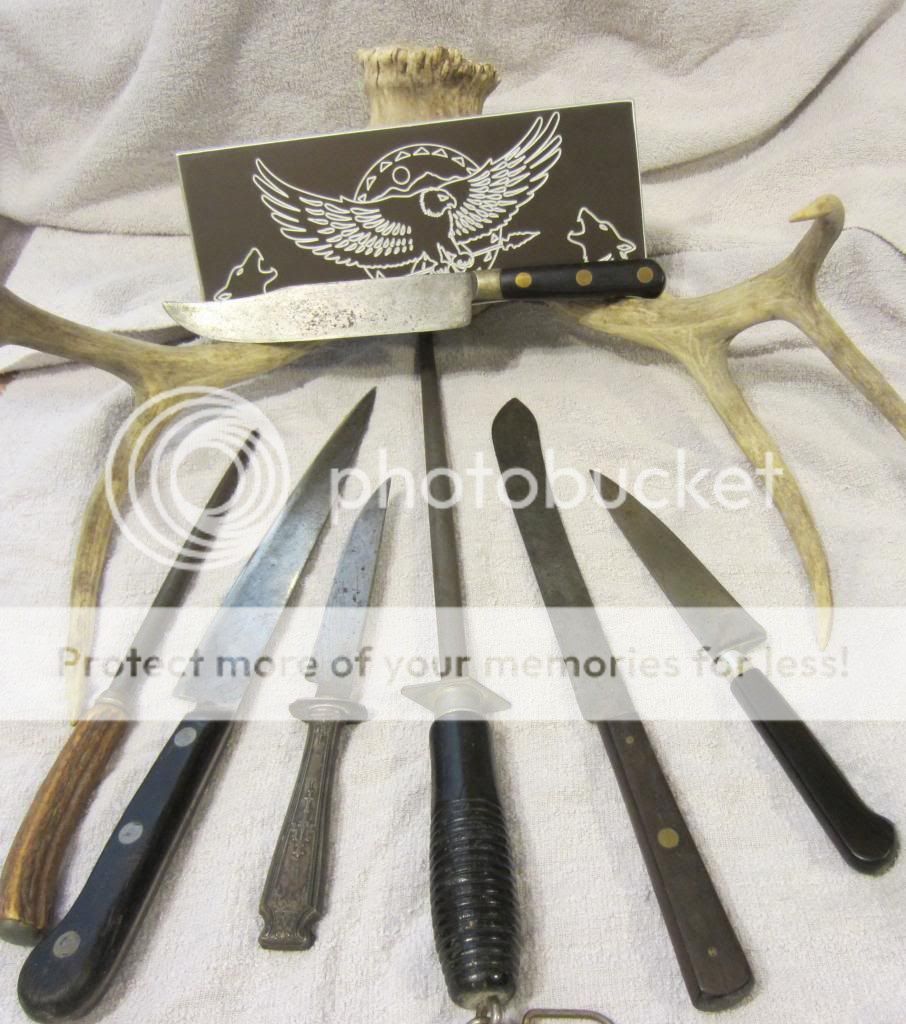- Joined
- Jul 18, 2015
- Messages
- 12
While at the local thrift I decided to look for serving ware, I did find some passably ornate holed spoons and spatulas for daily use but I also found some nice looking knives. While in store I did a few quick searches that led to this site...so I joined. I think I replaced some real crap but dont know much about knives.
Replaced these.

I'm not even sure where most of these came from... probably my mothers junk drawer. The only purchased knife here was the kitchen aid because I was going nuts using the others. Its the newest knife there and arguably in the worst condition. The only other branded one is a Henckel international 32084-180mm brazil, tempted to keep it because henckel is a good brand? The others are unbranded marked stainless china only.
These are the replacements

The gold 3 are what initially caught my eye because of the shape. This site was the only decent info source on these. They are marked 400c Gold 3 stainless Japan on the reverse they each have a number; QR4842 and PQ9828. They have a nice flex and are great for deboning (did a turkey with the long one).
Next up is the Oneida Japan set of two. There are no other markings on the blades. The only thing I know about Oneida is it was formed by some religious commune. In any case these knives have thick sturdy blades and nice long comfortable handles.
The last knife I picked up at thrift reads kaicut, swedish steel rostfrei inox - sandvik 13c26. The backside says japan. A smooth dark wide handle with slight flex to the blade. This knife feels like a classic knife, no frills or gimmicks, just knife.
The last knife I picked up at a yard sale. It looks like a prop from a horror film. The blade reads hand ground, Solingen,Germany there is a partialy readable logo that says Premier ?super? Steel Trade-mark, the super part may say something else. The tip is snapped and much of the blade is very rough.
I bought these for about $23 Cad and the Psycho knife was $2.
I have been using them as is and they are much better than what I had before, also they look much nicer.
I am wondering if any of these are considered good knives and what i should be doing to fix them up, especially the hand ground one as its in such rough shape.
Replaced these.

I'm not even sure where most of these came from... probably my mothers junk drawer. The only purchased knife here was the kitchen aid because I was going nuts using the others. Its the newest knife there and arguably in the worst condition. The only other branded one is a Henckel international 32084-180mm brazil, tempted to keep it because henckel is a good brand? The others are unbranded marked stainless china only.
These are the replacements

The gold 3 are what initially caught my eye because of the shape. This site was the only decent info source on these. They are marked 400c Gold 3 stainless Japan on the reverse they each have a number; QR4842 and PQ9828. They have a nice flex and are great for deboning (did a turkey with the long one).
Next up is the Oneida Japan set of two. There are no other markings on the blades. The only thing I know about Oneida is it was formed by some religious commune. In any case these knives have thick sturdy blades and nice long comfortable handles.
The last knife I picked up at thrift reads kaicut, swedish steel rostfrei inox - sandvik 13c26. The backside says japan. A smooth dark wide handle with slight flex to the blade. This knife feels like a classic knife, no frills or gimmicks, just knife.
The last knife I picked up at a yard sale. It looks like a prop from a horror film. The blade reads hand ground, Solingen,Germany there is a partialy readable logo that says Premier ?super? Steel Trade-mark, the super part may say something else. The tip is snapped and much of the blade is very rough.
I bought these for about $23 Cad and the Psycho knife was $2.
I have been using them as is and they are much better than what I had before, also they look much nicer.
I am wondering if any of these are considered good knives and what i should be doing to fix them up, especially the hand ground one as its in such rough shape.



